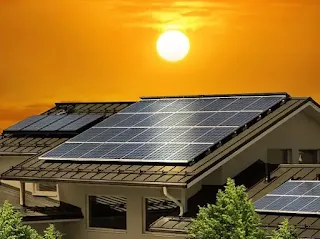ഇലക്ട്രിക്ക് വാഹന വിപണി ഏറെ സജീവമാകുകയാണ്.കൂടുതൽ ആളുകളും ഇലക്ട്രിക്ക് വാഹനങ്ങൾ തിരഞ്ഞെടുക്കാനുള്ള പ്രധാന കാരണമായി പറഞ്ഞിരുന്നത് പെട്രോൾ അടിക്കേണ്ട എന്നാണ്..
എന്നാൽ പെട്രോളിന് വില കയറുന്നതു പോലെ പതിയെ പതിയെ വൈദ്യുതിക്കും വില കൂടുകയാണ്..
വൈദ്യുതി ചാർജ്ജ് ഇനിയും കൂടും ..
ഗ്യാസടുപ്പ് ഷെൽഫിൽ വെച്ച് ഇൻഡക്ഷൻ കുക്കർ പുറത്തെടുത്ത വീട്ടമ്മമാരൊക്കെ ഇൻഡക്ഷൻ തിരിച്ചുവെക്കാൻ വീണ്ടും തട്ടിൻപുറത്ത് കയറി തുടങ്ങി..
ആ സ്ഥിതിക്ക് ഇനി ആകെ ചെയ്യാനാകുന്ന കാര്യം വൈദ്യുതി ബിൽ കുറയ്ക്കുക എന്ന് മാത്രമാണ്.
അതിനുള്ള ഏറ്റവും നല്ല മാർഗ്ഗം സോളാർ പോലെയുള്ള ബദൽ മാർഗ്ഗങ്ങളിലേക്ക് വീട്ടിലെ വൈദ്യുതി ഉപയോഗത്തെ പറിച്ചു നടുവാനുള്ള ശ്രമങ്ങളാണ്.
സോളാർ പ്ലാന്റ് ഒരെണ്ണം വീട്ടിൽ സ്ഥാപിക്കാൻ കേന്ദ്ര സർക്കാർ വക സബ്സിഡി ലഭിക്കും.വീടിന്റെ മുകളിലോ പറമ്പിലോ ഒക്കെയായി ഇത് സ്ഥാപിക്കാനുമാകും.
10 കിലോവാട്ട് വൈദ്യുതി സോളാർ വഴി നിർമിക്കാൻ കഴിയുന്നുണ്ടെങ്കിൽ ആദ്യത്തെ 3 വാട്ടിന് ബെഞ്ച് മാർക്ക് കോസ്റ്റിന്റെ 40 % സബ്സിഡി ലഭിക്കും.
3 കിലോവാട്ടിന് മുകളിൽ 10 കിലോവാട്ട് വരെ ബെഞ്ച് മാർക്ക് കോസ്റ്റിന്റെ 20 % വരെയും സബ്സിഡി ആയി ലഭിക്കും..
ബെഞ്ച് മാർക്ക് കോസ്റ്റ് ,കേന്ദ്ര നവ പുനരുപയോഗ ഊർജ മന്ത്രാലയം നിശ്ചയിക്കും.
പദ്ധതിയുടെ ഭാഗമാകുന്നതിന് ekiran.kseb.in എന്ന പോർട്ടൽ വഴിയാണ് അപേക്ഷ കൊടുക്കേണ്ടത്.
എം പാനൽ ചെയ്യപ്പെട്ട 30 ഓളം ഡെവലപ്പര്മാർ നിങ്ങളെ പദ്ധതി പൂർത്തീകരണത്തിൽ സഹായിക്കാനായി ഉണ്ട്.ഇവരുടെ ലിസ്റ്റും ചാർജുമൊക്കെ ആ വെബ്സൈറ്റിൽ തന്നെയുണ്ട്.
നിങ്ങൾക്ക് പറ്റിയ ആളെ നിങ്ങൾക്ക് തന്നെ തിരഞ്ഞെടുക്കാം...
അപേക്ഷാ ഫീസ് ഉണ്ടല്ലോ ..ഒരു 1180 രൂപ .അത് അടക്കേണ്ട ചുമതലയും ഡവലപ്പറുടേതാണ്.
പ്ലാന്റ് കോസ്റ്റിൽ നിന്നും സബ്സിഡി കുറച്ചിട്ടുള്ള തുക മാത്രമാണ് ഡെവലപ്പർക്ക് കൊടുക്കേണ്ടത്.
സൗര സബ്സിഡി പദ്ധതിയനുസരിച്ച് ഒരു കിലോവാട്ട് സോളാർ പ്ലാന്റ് സ്ഥാപിക്കാൻ നിലവിൽ 56065 രൂപയാണ് ചെലവ് ഉണ്ടാവുക.
ഇതിൽ 18800 രൂപ സബ്സിഡി കുറച്ച് 37265 രൂപ ഡവലപ്പർക്ക് നൽകണം. ഒരു കിലോവാട്ട് നിലയത്തിൽ നിന്ന് പ്രതിമാസം 120 യൂണിറ്റ് വൈദ്യുതി ലഭിക്കും.
ഈ കണക്ക് അടിസ്ഥാനപ്പെടുത്തി വീടിനു മുകളിൽ സോളാർ പ്ലാന്റ് വെച്ചാൽ പ്രധാന ഗുണം ഒന്നേയുള്ളൂ...
കറണ്ട് ബില്ല് കാണുമ്പോൾ ഷോക്കടിക്കേണ്ടി വരില്ല.
Solar Subsidy by Central Government: A Boost to Green Energy
The Central Government in India has been actively promoting the adoption of solar energy through various subsidy schemes.
One of the most prominent initiatives is the PM Surya Ghar Muft Bijli Yojana. Key Features of the Solar Subsidy Scheme
- Subsidy Amount: The subsidy varies based on the capacity of the solar power system.
- Up to 2 kW: Rs. 30,000 per kW
- Additional capacity up to 3 kW: Rs. 18,000 per kW
- Total subsidy for systems larger than 3 kW: Maximum Rs. 78,000
- Beneficiaries: Residential homeowners are the primary beneficiaries of this scheme.
- Process: The subsidy is directly credited to the beneficiary's bank account after successful installation and verification.
Benefits of Solar Subsidy
- Reduced upfront costs: The subsidy significantly reduces the initial investment in solar panels.
- Faster ROI: With lower installation costs, you can enjoy quicker returns on your investment.
- Environmental benefits: Contributing to a cleaner and greener environment.
- Energy independence: Reducing reliance on traditional power sources.
Additional State-Level Incentives
While the central government offers substantial subsidies, several state governments also provide additional incentives to promote solar energy adoption. It's essential to check with your state's energy department for specific details.
Note: The solar subsidy landscape is dynamic, and policies may change. It's recommended to consult the official government websites or consult with a solar energy expert for the most up-to-date information.
Solar subsidy in India: Learn about the central government's incentives and schemes to promote solar rooftop installations. Discover eligibility criteria, subsidy amounts, and the application process. Find out how to save money on solar panels and contribute to a greener future.
Keywords: solar subsidy, solar panel subsidy, government subsidy, solar rooftop, solar energy, renewable energy, India, central government scheme, subsidy eligibility.
